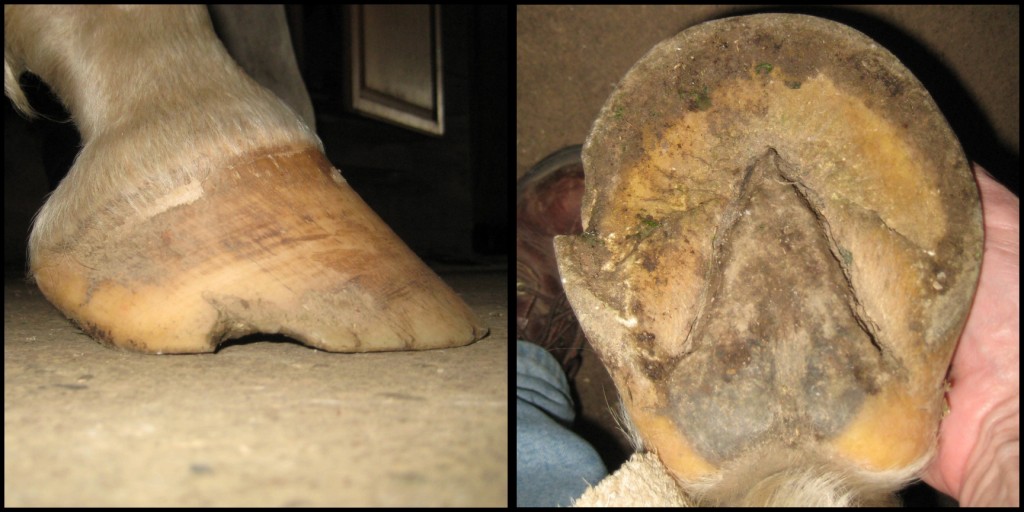I’m always trying to better understand, and therefore help clients understand, the horse and hoof issues that cause them (the horse owners) any sort of stress. So when I received a call from a client the other day who was concerned about a chip in her horse’s hoof, I decided I’d take the opportunity to try to get a better handle on what goes through a client’s mind when he/she is confronted with this particular situation.
As you can see in the photos below, this big American Quarter Horse had broken out a piece of hoof wall on his right rear hoof; not particularly surprising since the owner does a fair amount of trail riding with him, and he was already scheduled to be trimmed a few days later. This horse, by the way, had received less-than-optimal hoof care before I had taken him on 2 or 3 years ago. In fact, his feet were trimmed along the lines of what I tend to call the “typical farrier trim,” which has all or most of the following characteristics:
- The bearing surface of the hoof wall (the “bottom”) is trimmed flat
- The toe is trimmed too short
- The heel buttresses (“heels”) are left too long
- The primary weight-bearing areas of the hoof wall (the heel buttresses and one or two areas in the toe region) are unbalanced – accidentally or intentionally – with respect to each other
- The sole is not properly exfoliated
- The bars are not blended into the exfoliated sole
- The frog is too long
(Incidentally, I’m painfully aware that these need a lengthier and more detailed explanation, and I promise you I’ll being doing that in the very near future!)
As a consequence, his hooves weren’t functioning properly, and he had had problems with cracks. But since I’ve taken over his hoof care, and in spite of the fact that (like many horses) he’s somewhat sensitive to dietary and environment issues, he’s been growing well-functioning, good-quality hooves with no cracking.
After reassuring the client that I absolutely wasn’t ridiculing her for calling me out early, I asked her to be as specific as possible about what went through her head when she looked at this hoof. She told me she knew he wasn’t lame because of it, but was concerned that he might end up being lame if he didn’t have the hoof trimmed sooner rather than later. She also reminded me about his history with quarter cracks, and didn’t want to risk a repeat of those problems.
I picked up the foot and showed her that the broken-out portion hadn’t involved any living tissue. She seemed surprised by that news (which is my fault!), so I explained that, similar to a person’s fingernail, the hoof wall itself consists of dead tissue. As long as the living tissue that attaches the hoof wall to the coffin bone isn’t violated, there’s no problem. That, by the way, is why farriers are able to drive a nail into the hoof wall without causing any instant lameness, and also why a misplaced nail – one that encroaches on living tissue – does cause an instant lameness. Since the living tissue attachment ends at the sole, any chipping that occurs below the sole is never a cause for concern; it’s simply, as I’ve pointed out in previous Posts, nature doing my job for me by removing excess growth to facilitate efficient movement. The heel quarters are by far the most common area for chipping to occur in because the hoof wall is generally thinnest in that area. As you can see in the following pair of photos taken after trimming, the only remnant of the chip is the slight “tear” that extended up past the sole on the very outside of the wall. Note also that the bearing surface of the hoof wall is not flat – there’s a slight relief in the heel quarter area that reflects the natural arch of the foot. Nice hoof!
So next time you see a chipped-up hoof, please don’t panic. Don’t even worry. Just remind yourself that it’s nature trying to get a jump-start on the trimmer’s job, and it’s time for a trim…

